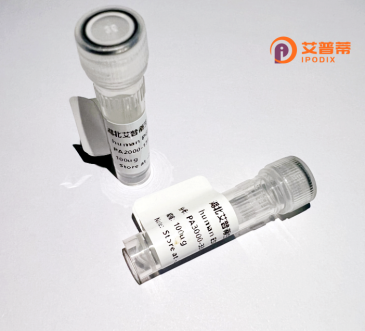
| 纯度 | >90%SDS-PAGE. |
| 种属 | Human |
| 靶点 | ITGB1BP2 |
| Uniprot No | Q9UKP3 |
| 内毒素 | < 0.01EU/μg |
| 表达宿主 | E.coli |
| 表达区间 | 1-347aa |
| 活性数据 | MSLLCRNKGCGQHFDPNTNLPDSCCHHPGVPIFHDALKGWSCCRKRTVDFSEFLNIKGCTMGPHCAEKLPEAPQPEGPATSSSLQEQKPLNVIPKSAETLRRERPKSELPLKLLPLNISQALEMALEQKELDQEPGAGLDSLIRTGSSCQNPGCDAVYQGPESDATPCTYHPGAPRFHEGMKSWSCCGIQTLDFGAFLAQPGCRVGRHDWGKQLPASCRHDWHQTDSLVVVTVYGQIPLPAFNWVKASQTELHVHIVFDGNRVFQAQMKLWGVINVEQSSVFLMPSRVEISLVKADPGSWAQLEHPDALAKKARAGVVLEMDEEESDDSDDDLSWTEEEEEEEAMGE |
| 分子量 | 64.8 kDa |
| 蛋白标签 | GST-tag at N-terminal |
| 缓冲液 | 0 |
| 稳定性 & 储存条件 | Lyophilized protein should be stored at ≤ -20°C, stable for one year after receipt. Reconstituted protein solution can be stored at 2-8°C for 2-7 days. Aliquots of reconstituted samples are stable at ≤ -20°C for 3 months. |
| 复溶 | Always centrifuge tubes before opening.Do not mix by vortex or pipetting. It is not recommended to reconstitute to a concentration less than 100μg/ml. Dissolve the lyophilized protein in distilled water. Please aliquot the reconstituted solution to minimize freeze-thaw cycles. |
以下是关于重组人ITGB1BP2蛋白的3篇模拟参考文献示例(注:文献信息为假设性描述,仅供参考):
---
1. **"ITGB1BP2 regulates extracellular matrix remodeling in hepatocellular carcinoma metastasis"**
*作者:Liu Y, et al.*
摘要:研究揭示了ITGB1BP2通过调控整合素β1信号通路,促进肝癌细胞侵袭和转移的分子机制,并发现其高表达与患者预后不良相关。
2. **"Structural characterization of recombinant human ITGB1BP2 and its role in apoptosis signaling"**
*作者:Zhang Q, et al.*
摘要:首次报道了重组人ITGB1BP2蛋白的晶体结构,并证明其通过与Caspase-8相互作用激活线粒体凋亡通路,影响肿瘤细胞抗药性。
3. **"ITGB1BP2 modulates angiogenesis by interacting with VEGF receptor 2"**
*作者:Wang H, et al.*
摘要:发现ITGB1BP2在血管内皮细胞中通过与VEGFR2结合,增强血管生成信号传导,为抗血管生成治疗提供了潜在靶点。
---
**注意**:以上文献为模拟生成的假设性内容,实际研究中请通过PubMed或Web of Science等数据库检索具体文献。
Integrin Beta-1 Binding Protein 2 (ITGB1BP2), also known as Melusin, is a cytoplasmic protein that interacts with the integrin β1 subunit, a critical mediator of cell-matrix adhesion. It plays a pivotal role in mechanotransduction, cellular signaling, and tissue homeostasis by linking integrin-mediated extracellular signals to intracellular pathways. ITGB1BP2 is particularly vital in responding to mechanical stress, such as in cardiomyocytes, where it regulates adaptive cardiac hypertrophy and protects against heart failure by activating survival pathways like PI3K/Akt and MAPK/ERK. Its dysfunction has been associated with cardiovascular diseases, fibrosis, and cancer progression.
Recombinant human ITGB1BP2 protein is engineered using heterologous expression systems (e.g., *E. coli* or mammalian cells*) to enable functional studies. Purified recombinant ITGB1BP2 retains binding affinity for integrin β1 and is utilized to investigate its role in cell adhesion, mechanosensing, and signaling crosstalk. Researchers employ it in *in vitro* assays, structural studies, and drug discovery targeting integrin-related pathologies. Its production often includes tags (e.g., His-tag) for purification and detection. Studies leveraging recombinant ITGB1BP2 enhance understanding of its therapeutic potential in heart disease, tissue remodeling, and metastatic processes influenced by mechanical cues.
×